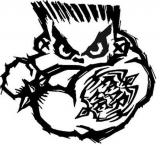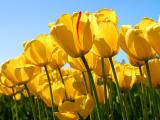Things invisible to the human eye can often be seen under UV light, which comes in handy for both scientists and detectives.
Humans breathe out carbon dioxide (CO2). Using energy from sunlight, plants convert carbon dioxide into food during a process called photosynthesis.
Chemical reactions occur all the time, including through everyday activities such as cooking. Try adding an acid such as vinegar to a base such as baking soda and see what happens!
Above 4 °C, water expands when heated and contracts when cooled. But between 4 °C and 0 °C it does the opposite, contracting when heated and expanding when cooled. Stronger hydrogen and oxygen bonds are formed as the water crystallizes into ice. By the time it's frozen it takes up around 9% more space.
Often formed under intense pressure over time, a crystal is made up of molecules or atoms that are repeated in a three dimensional repeating pattern. Quartz is a well known example of a crystal.
Athletes at the Olympic Games have to be careful how much coffee they drink. The caffeine in coffee is a banned substance because it can enhance performance. One or two cups are fine but they can go over the limit with more than five. (update - as of 2004 caffeine has been taken back off the WADA banned list but its use will be closely monitored to prevent future abuse by athletes.)
Humans breathe out carbon dioxide (CO2). Using energy from sunlight, plants convert carbon dioxide into food during a process called photosynthesis.
Chemical reactions occur all the time, including through everyday activities such as cooking. Try adding an acid such as vinegar to a base such as baking soda and see what happens!
Above 4 °C, water expands when heated and contracts when cooled. But between 4 °C and 0 °C it does the opposite, contracting when heated and expanding when cooled. Stronger hydrogen and oxygen bonds are formed as the water crystallizes into ice. By the time it's frozen it takes up around 9% more space.
Often formed under intense pressure over time, a crystal is made up of molecules or atoms that are repeated in a three dimensional repeating pattern. Quartz is a well known example of a crystal.
Athletes at the Olympic Games have to be careful how much coffee they drink. The caffeine in coffee is a banned substance because it can enhance performance. One or two cups are fine but they can go over the limit with more than five. (update - as of 2004 caffeine has been taken back off the WADA banned list but its use will be closely monitored to prevent future abuse by athletes.)
Hi :DÂ Friends:)


